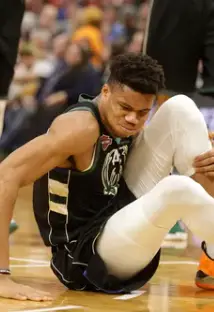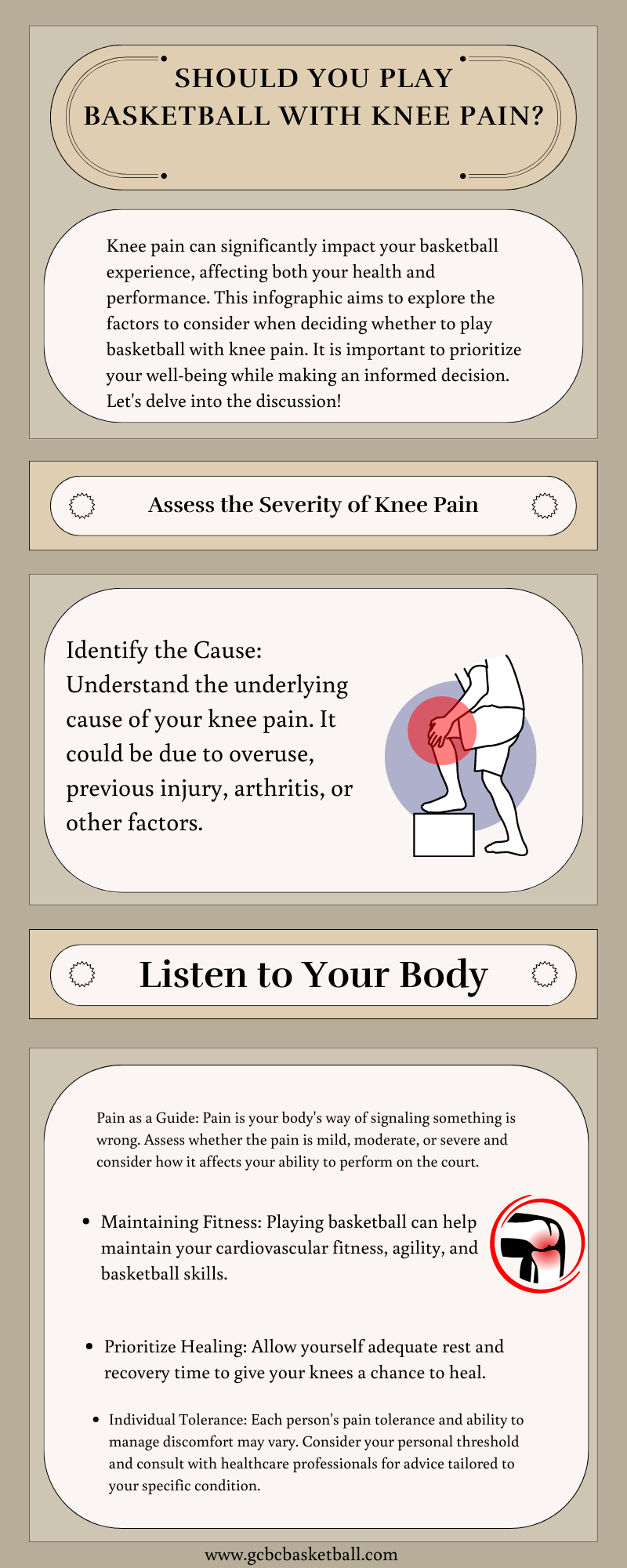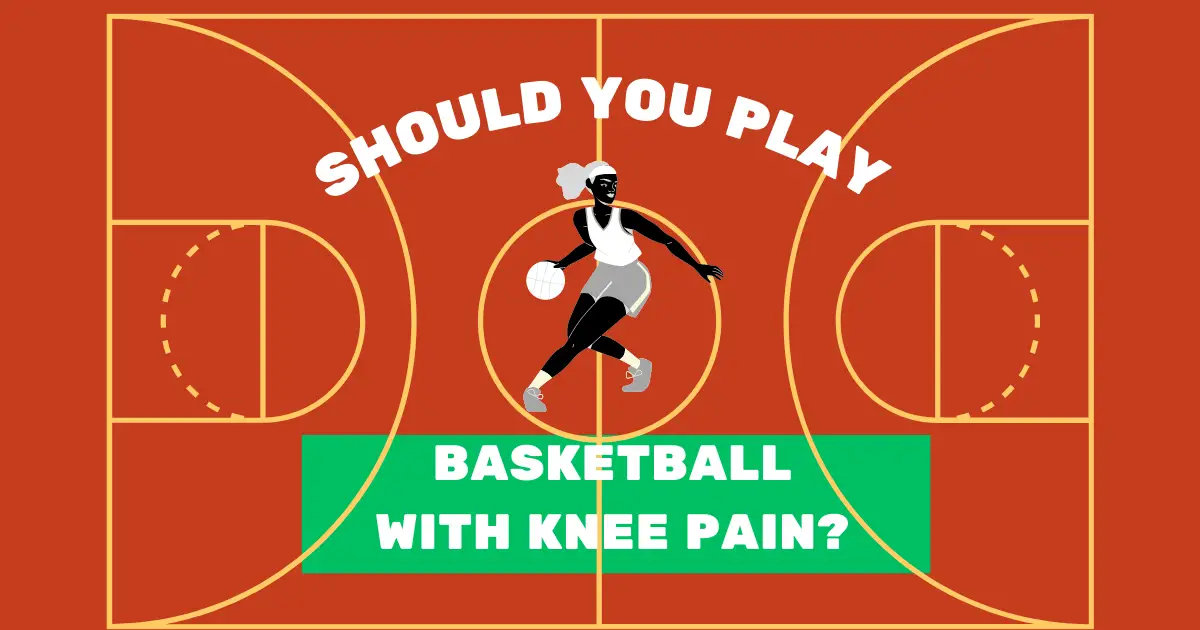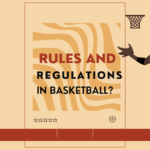Knee pain is one of the most common issues for basketball players. It can significantly impact performance and potentially lead to more severe health problems if not addressed properly. If knee pain is only minor, it may be possible to continue playing while taking steps to reduce inflammation. This could include getting extra rest, icing the affected area, and taking anti-inflammatory medication as prescribed by a doctor. However, if symptoms are severe or persist over an extended period, it’s important to stop playing basketball until you consult your doctor for further treatment options.
Reasons Not To Play Basketball With Knee Pain:
It Can Worsen Your Injury:

Engaging in physical activity while in discomfort can cause further damage to an already injured area. Basketball involves sudden changes of direction, which strain the knees and can easily aggravate any existing injuries.
Ongoing movements while experiencing knee pain can lead to inflammation of the joint and surrounding muscles and ligaments. As such, exacerbating an existing issue should be avoided if possible.
The Emotional Impact:

A considerable amount of time and dedication goes into the sport, so it’s understandable that an athlete would want to compete despite any discomfort. If a player continues to participate in the game despite knee pain, there is a possibility that this could lead to emotional strain.
It Can Lead To Permanent Damage:

Playing on an injured knee can cause permanent damage and even prematurely end your basketball career. Furthermore, if your knee continues to give you problems after playing, this could result in more expensive medical treatments down the line.
What Are The Causes Of Knee Pain In Basketball?

In basketball, sudden changes in direction and jumping put a lot of stress on the knees. This can lead to inflammation and swelling, as well as tears in ligaments and tendons. Basketball players may also experience patellar tendonitis or Iliotibial Band Syndrome (commonly referred to as IT band syndrome). These conditions can cause severe discomfort, swelling, and tenderness around the kneecap area. Additionally, those who don’t warm up properly before playing may be more susceptible to knee injuries.
How To Avoid Knee Pain While Playing Basketball?
- Warm-Up

Warm up properly before each game or practice session. A good warm-up routine should involve dynamic stretching exercises such as lunges, squats, leg swings, and high knees that target the muscles around your hips, legs, and core. This helps loosen up the muscles and prepare them for a strenuous activity like jumping or running. Additionally, light jogs or skipping can help improve blood circulation throughout your body and reduce muscle stiffness before you start playing.
- Electric Muscle Stimulation
EMS is a technique that sends electrical impulses directly to muscles, helping them contract and relax. The electrical current stimulates the muscles, allowing them to move freely without feeling strained or painful. Electric muscle stimulation can be used during physical activity and recovery.
The benefits of using electric muscle stimulation include increased blood flow, improved range of motion and flexibility, faster recovery time from injuries or surgeries, decreased muscle tension and joint stiffness, and reduced pain levels. It’s important to note that there are some risks associated with EMS, such as overstimulation which can cause excessive fatigue or even burns on the skin.
- Compression
Compression garments are designed to support the knee joint and surrounding muscles, providing comfort and limiting swelling. Selecting the compression garment that fits properly and provides adequate coverage from the ankle up to just below the knee is essential.
Choosing a garment that is lightweight but still offers great support will help protect against injury while allowing for freedom of movement on the court. Compressing your discomfort may also reduce inflammation and muscle soreness, aiding recovery after an intense game or practice session.
- Adequate Rest
Listen to what your body is telling you when playing basketball with knee pain. Allowing yourself time for adequate rest can help reduce inflammation and soreness in the areas around your knees. Try taking long hot baths or using a heating pad on the affected area before returning to the court. Additionally, stretching regularly can help improve flexibility and reduce knee pain.
Get In Good Physical Shape:
Support your knees while playing on-court by strengthening muscles around the knee joint. Additionally, stretching exercises help increase mobility and reduce potential stress on your joints when playing basketball. Cardio exercises like running or biking also help improve endurance while reducing chances of injury due to fatigue during games or practices.
Stay Hydrated:
Hydration helps flush out toxins in the body, allowing your muscles and organs to function optimally. Proper hydration can help reduce muscle fatigue, cramping, and joint stiffness when playing sports like basketball. Staying hydrated can also contribute to faster recovery following a workout or competitive match.
What Do Nba Players Do For Knee Pain?
NBA players are no strangers to the aches and pains that come with being professional athletes and have developed different ways of dealing with knee pain. Many use specialized treatments, such as stem cell therapy or PRP (platelet-rich plasma) injections, while others rely on tried-and-true methods like rest and ice therapy.
How To Treat Knee Pain?
Taking time away from the court will help alleviate pressure on the joint and allow it to heal properly. Ice should also be applied to reduce swelling, followed by gentle stretching exercises to help keep the muscles around the affected area solid and flexible. If needed, over-the-counter medications like ibuprofen can also be taken as directed to reduce swelling and discomfort further.
InfoGraphics:

Conclusion:
Playing basketball with knee pain is not recommended. It can cause more damage and worsen the injury. Instead, it is essential to rest and seek medical attention if the pain does not disappear. Ice, compression, and elevation can also help reduce swelling and discomfort in the knee. If physical therapy or surgery is necessary, it is best to follow your doctor’s orders for a full recovery.

Clyde Jackson III is a basketball coach and the founder of GCBC Basketball, a basketball-related learning and informational website that focuses on helping young players develop their skills on and off the court. With over 15 years of coaching experience, Clyde has worked with players of all ages and skill levels, from beginners to professionals.















